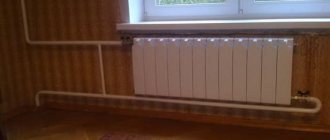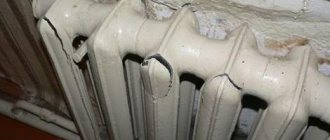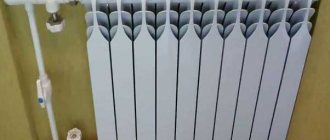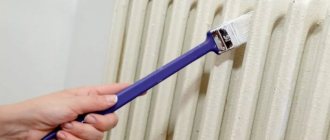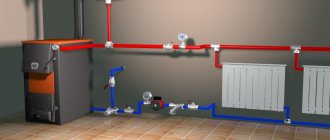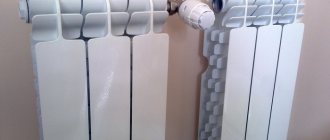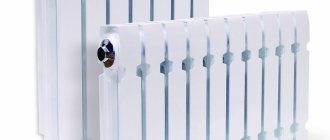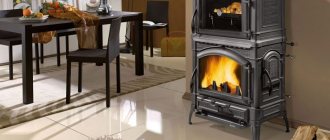Specifications
Kermi radiators with bottom connections are used when the heating system in the house is located under the floor.
Along with the installation of radiators, it is necessary to install connection nodes. They will protect the premises from flooding in the event of an accident.
Design Features
The design of Kermi FTV 22 steel radiators includes two panels with U-shaped fins between them. The installation depth is 100 mm.
For the manufacture of all elements of the heating device, high-quality steel with an anti-corrosion coating is used. To prevent the accumulation of contaminants, the inner surface is subjected to special treatment. High strength of the coating is achieved through the use of high-temperature heating.
This model of panel radiators provides a bottom connection. Pipes supplying energy can be hidden in the floor, baseboard or wall, which makes the design of the heating system more aesthetically pleasing.
The panels are made of profiled sheet steel and the channels are fastened using electric arc spot welding. The perimeter of the structure is connected with a continuous or roller seam. The use of this technology allows us to achieve a high level of strength and tightness of the seam. The quality of the welded joint is controlled by testing under a certain load under conditions corresponding to pressure testing of the heating system.
Advantages of radiators with bottom connections
All Kermi models have a modern and compact appearance. In addition to aesthetic properties, there are other important advantages:
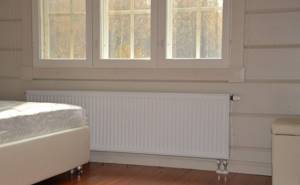
- the presence of a unit that turns off the radiator in one room and does not affect other rooms in the house;
- bottom connection is used in panel and tubular models;
- easy installation and ease of operation of the product, the ability to hide pipes and wires under the floor;
- such radiators can be installed in any heating system, varying capacities and designs;
- the presence of a thermostat and thermostatic valve.
Kermi heating radiators provide an opportunity to save on home heating costs, since it is possible to heat only some rooms.
Thermal head: operating principle
The thermal head is a special device that is necessary to regulate the temperature in the radiator. The first versions of such heads appeared back in 1943, developed by DANFOSS.
Several decades have passed since the appearance of the first thermostatic heads with a remote sensor. Naturally, as is the case with any other technology, during this time the product has undergone a huge number of changes, as a result of which the quality and accuracy of thermostats has increased. Their design consists of only two main parts: a valve and a thermal head. They are connected by a special fixation mechanism.
The very principle of operation of the mechanism is as follows: the thermal head constantly measures and analyzes the temperature of the radiator and influences it with a valve that opens and closes the flow of water into the radiator.
This method of temperature control is called quantitative, since the mechanism changes the amount of coolant that passes through the heating radiator. There is another method called qualitative. The point here is to regulate the temperature directly in the system itself. This issue will be solved by a special mixing unit, which is installed in the boiler room.
Heater models
FTV type radiators used to be marked VKF. Now, thanks to the new German Therm X2 technology, structures are heated sequentially. This operating principle saves energy when heating.
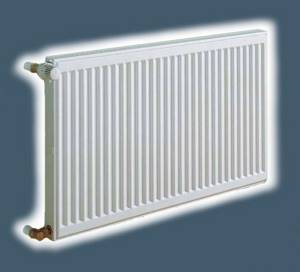
The equipment is equipped with a thermostatic insert into which the thermostat is mounted. It regulates the temperature in the room and always maintains it in the set mode. There are four main groups of FTV radiator models, differing in depth: 11 (59 mm), 12 (64 mm), 22 (100 mm), 33 (155 mm).
Options for increasing heat transfer
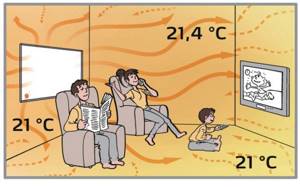
Any control device can lower the battery temperature. It is impossible to force a radiator to give off more heat. If the radiators in the apartment are cold, and the temperature in the room does not meet the standards (for corner rooms it is +20-22, for the rest - +18), you can try to change it in the following ways:
- try to remove air pockets in the batteries and clean the pipes and filters;
- analyze the connection diagram and possibly change it;
- add the required number of radiators.
I would like to dwell on the last point. When comfort in the apartment is at stake, it is advisable to avoid mistakes in choosing radiators, because it will be impossible to change anything.
Purmo steel panel devices show good results. The built-in convection elements of these batteries provide accelerated heating of the room; they can be used in both single-pipe and two-pipe heating options.
Their worthy competition is the company RIFAR Base, which presents a whole line of bimetallic and aluminum radiators. These batteries are able to withstand high pressure and perform their functions normally during significant surges in heating networks. The heat transfer rate of these heating devices is very high. The RIFAR Base 500 model is the most powerful in the range of bimetallic devices, and is designed for heating large rooms with poor thermal insulation.
German Kermi radiators deservedly enjoy a good reputation. They are steel or bimetallic. Three types of metal of varying thickness are used for production. Kermi heating equipment is mainly suitable for installation in cottages and private houses.
Models Kermi FTV 11
Bottom-connected radiators of this type are universal in design and excellent in quality, but are suitable for small spaces. The batteries provide heat with a convection element and just one panel. This type of heating equipment has the following properties:
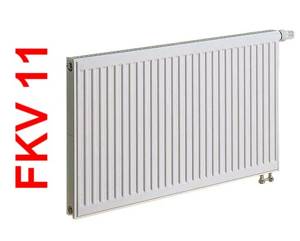
- high-strength carbon steel has powerful heat dissipation;
- the presence of a corrugated panel ensures heat dissipation around the entire perimeter;
- working pressure – 10 bar;
- bottom connection through two external pipes.
Price
The price of heaters depends on the individual characteristics of each model. The cost is affected by height, width, capacity, heat transfer. The higher the indicators, the higher the cost. A few examples:
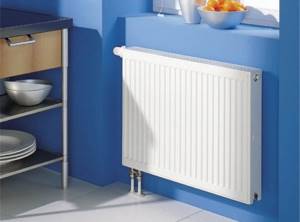
- heating radiators with a height of 300 mm, a width of 400 mm, a heat output of 298 W and a capacity of 0.72 l cost 2,500 rubles;
- heaters 600x1200 mm with a heat output of 1615 W and a capacity of 3.78 liters cost 5,000 rubles;
- a Kermi radiator 900x3000 mm with a heat output of 5778 W and a capacity of 13.5 liters costs an average of 13,000 rubles.
The minimum cost of heating equipment is 2,500 rubles, the maximum can reach up to 21,000 rubles.
Thanks to the smooth glossy surface, the heating device can be easily repainted or galvanized for installation in the bathroom.
Peculiarities
Unlike standard heaters, which have a pressure of 8.7 bar, Kermi radiators maintain a pressure of 10 bar. All models demonstrate high heat transfer coefficient and low energy absorption.
Installing a thermal head on a heating radiator
As mentioned earlier, it is best to install a thermostatic valve in a horizontal position relative to its axis.
You also need to know that there is no need to install mechanisms on absolutely every battery in your heating system. There is a rule that has been formed over decades. It sounds like this: only those radiators that in total have a little more than 50 percent of the total power of the system need adjustment. For example, if there are only 2 heating radiators in the house , you need to choose a powerful one and install a thermal valve on it.
It is also worth considering that if we are talking about cast iron radiators, then the use of a thermostatic valve will be as ineffective as possible, that is, useless. The reason for this is that such radiators are inert, which leads to a large adjustment delay, which will be of no use. Therefore, installing thermostats on cast iron batteries is a pointless exercise.
It is best to install the valve on the supply pipe when it is connected to the general system. If this happens in an already assembled heating system, then dismantling some elements and cutting pipes cannot be avoided, which will lead to great inconvenience.
After the valve has already been installed, the thermal head is installed very easily by aligning the corresponding marks on the material bodies and fixing the device with a smooth press followed by a click, which serves as a signal that the mechanism is tightly fixed to the valve.
It is much more difficult to install the anti-vandal regulator, which was discussed above. At a minimum, you will need a 2mm hex key for this. Using dowels, it is necessary to secure a special mounting plate in the wall, and then secure the body of the mechanism itself to it. Next, you need to install the capillary tube to the wall using ordinary plastic clamps. And only after this can you fix the thermal head itself using a key.
On the back of any thermostatic regulator you can find limit fonts that serve to set the maximum and minimum values for the water temperature in the radiator.
Additional recommendations for installing thermal valves:
- Under no circumstances should the mechanism body be exposed to direct sunlight. This will very quickly lead to damage to the thermostatic head.
- Any furnishings must not overlap or hide the thermostatic element from the rest of the room. If you make this mistake, the air temperature next to the mechanism will be an order of magnitude higher than in the room. Also, the thermostat should not be placed above rising currents of heated air. For example, you cannot place it directly above the radiator.
- It is necessary to exclude the possibility of any kind of pressure on the thermostatic valve generated by the connected pipeline.
Models Kermi FTV 12
This model line has enhanced thermal conductivity: this property is provided by two heating panels with circulating coolant (in the FTV 11 line there is 1 panel).

The heaters are equipped with one convection element, due to which the radiator, even with the same dimensions as the FTV 11 model, is capable of generating significantly more heat.
Characteristics
Heating devices with bottom connections have the following properties:
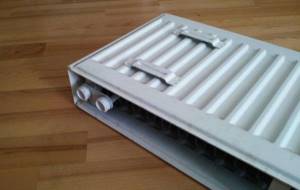
- material – high carbon steel;
- compact appearance and varnish treatment of the body;
- length – from 400 to 3000, height – from 300 to 900, depth – from 64;
- connection to the heating system through 2 external openings (Eurocone shape);
- The left pipe provides coolant supply, the right pipe provides return flow.
Price
The price of a radiator with a bottom connection also depends on the exact parameters: length, width, heat transfer and capacity. Thanks to the wide range of heating equipment, you can choose the most suitable device.
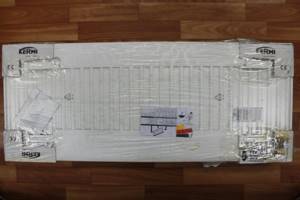
- model 300x400 with a heat output of 372 W and a capacity of 1.44 liters - from 3,000 rubles;
- radiator 500x1200 with heat output 1916 W, capacity 6.48 l - from 6000 rubles;
- heater 900x1000 with a heat output of 2314 W and a capacity of 9 liters - from 7,000 rubles.
The standard package includes: radiator, corner consoles, Mayevsky tap, plug, thermostatic valve.
Peculiarities
The equipment is easy to install. It is recommended not to remove the original packaging from the device until all installation work is completed - this will ensure the safety of the product. The base color of the device is white, but it can be changed to any other.
Call a specialist to install radiators in Moscow inexpensively

Naturally, no homeowner without experience in this matter can do the work of organizing a home heating system better than a professional. Therefore, many immediately decide to transfer the issue of organizing the system, purchasing heating devices and connecting them to a specialist who knows a lot about this and has considerable experience behind him.
The question of how much it costs to install radiators is of interest to many homeowners; on the Internet there are many advertisements of private craftsmen offering the service quite cheaply, but you should not trust the task to the first person you meet. Firstly, the master may not be qualified enough, and secondly, you can fall for scammers and lose money.
Therefore, it is better to call a plumber working in a specialized company, for example, our online store offers related services: delivery and installation of radiators. Our specialists have been working in this field for a long time, have experience, certificates confirming their qualifications, and also provide a guarantee for the work performed.
The installation of radiators is carried out by a specialist on a day convenient for you; the specialist brings all the necessary tools with him, so you do not need to look for or rent a drill and other tools necessary to connect the batteries.
The cost of installation depends on the number of radiators and the complexity of the work, in general it is inexpensive, the visit of a specialist is included in the price.
Models Kermi FTV 22
Equipment in this series can be installed even in the living room, and the bottom type of connection will ensure that all pipes and wires are hidden under the floor. Good thermal conductivity is ensured by two heating panels and two convection elements (in previous versions there was only one element).
Characteristics
Models with bottom connection Kermi 22 are characterized by:
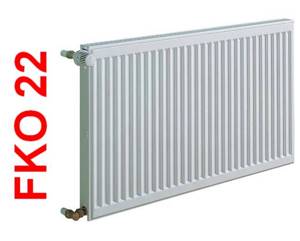
- material – carbon steel 1.25 mm thick;
- high heat transfer;
- not bulky dimensions;
- corrugated surface provides better heat distribution;
- pressure – 10 bar, length – from 400 mm, height – from 300 mm, depth – from 100 mm.
Price
This type of heater is designed for heating houses with spacious rooms. The presence of two convection elements allows you to make the heating system work more efficiently and quickly. The approximate cost of radiators of the FTV 22 type can be as follows:
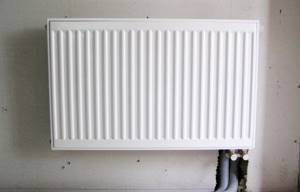
- a 400x2000 mm model with a heat output of 3210 W and a capacity of 9 liters will cost 9,000 rubles;
- radiator 600x2300 mm with heat output 5173 W, capacity 14.49 l - 11,000 rubles;
- a heater 900x1200 mm with a heat output of 3797 W and a capacity of 10.8 liters costs 9800 rubles.
The latest model is considered the most popular - it performs the maximum number of functions.
Peculiarities
Installation of radiators is carried out using brackets, which are placed at a distance of 30-50 mm.
Types and characteristics of Kermi heating devices
At the moment, the brand offers the following types of traditional steel batteries:
- profile therm X2 profil K (compact) and Profil V (valve);
- smooth therm X2Plan K (compact), Plan V (valve), Verteo Plan (vertical);
- with horizontal profiling of the front panel therm X2 line K (compact), Line V (valve), Verteo Line (vertical).
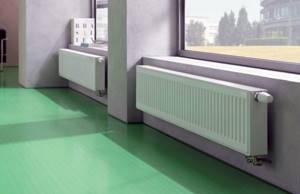
As for the types of radiators offered, all standard types are produced under the Kermi brand, from 10th to 33rd. Let us recall that the first number in the designation indicates the number of heating panels, and the second – the number of convective fins. The most popular is type 22, where 2 panels and the same number of fins are used, as shown in the figure:
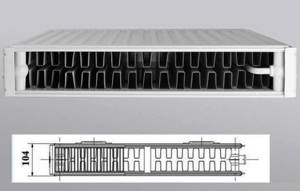
General technical characteristics of Kermi radiators are presented in the table below:
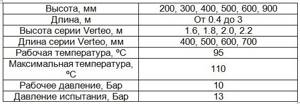
The listed 3 types of batteries differ in appearance by the type of profiling or lack thereof. While their heat transfer rates are somewhat different. It should be noted that the power of Kermi radiators is declared by the manufacturer in relation to the installation length. Therefore, first we present a table of the thermal power of 1 m of profiled devices (therm X2Profil) depending on the height, type and operating temperature curve of the coolant:
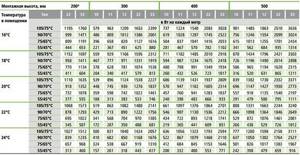
Below is a table of technical characteristics of Kermi therm X2 Plan and Kermi therm X2 Line radiators, per 1 m length:

Note. Since Kermi therm X2 Verteo vertical steel batteries are used much less frequently than traditional ones, we will not present their characteristics here. The corresponding tables can be studied on the manufacturer’s Internet resource.
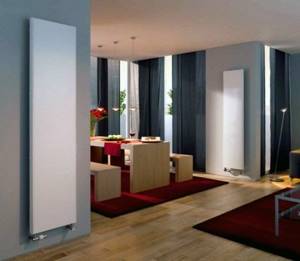
Models Kermi FTV 33
In terms of heat output, these models are recognized as one of the best heaters: they are ideal for large houses, they have many functions, and in general, such heating systems allow you to set different modes for individual rooms.
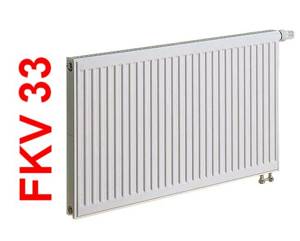
This line of heaters has the most powerful thermal conductivity thanks to three heating panels and three heat convectors.
Characteristics
All kermi equipment is made from the same materials, the only difference is in the number of heaters and parameters:
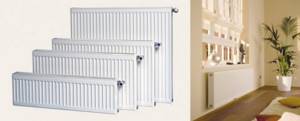
- strong steel with hydrocarbon gives strength and durability;
- good heat transfer;
- the presence of two heating pipes: supply and exhaust;
- the maximum number of heating panels on the heater market;
- external U-shaped appearance;
- height – from 300 mm, width – from 400 mm, depth – from 155 mm.
The kit includes all fasteners, air vent, thermostat valve.
Price
The price of the devices is higher than previous models, which is due to the greater heat transfer of FTV 33 radiators. Approximate prices are as follows:
- model 300x1600 with a heat output of 2939 W and a capacity of 8.64 liters costs 10,000 rubles;
- a 500x3000 heater with a heat output of 8319 W and a capacity of 24.3 liters costs 18,000 rubles;
- a 900x2000 radiator with a heat output of 8782 W and a capacity of 27 liters costs 22,000 rubles.
Peculiarities
Heating in the radiator is carried out sequentially, which ensures high heat transfer in large rooms. Kermi models can be mounted in a niche, but for this it is necessary to leave a small distance on the sides to be able to remove the end plates and grille.
Today there are three main types of connecting radiators to pipes:
- Diagonal;
- Lateral one-sided;
- Bottom radiator connection.
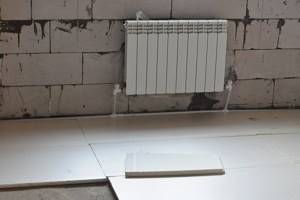
Let's briefly look at all three, focusing on the lower connection method. So, the diagonal connection method ensures the most efficient heat transfer. In this case, the pipe through which the coolant is supplied is located at the top, and the outlet pipe is at the bottom of the radiator. This placement allows for maximum power. If you use the reverse connection - the supply pipe is at the bottom and the outlet pipe is at the top - then the efficiency of the device drops by 10%.
Diagonal connection is well suited for long radiators, the number of sections of which is more than 10-12. With this type of connection, it is convenient to hide the pipes in grooves or behind a false wall.
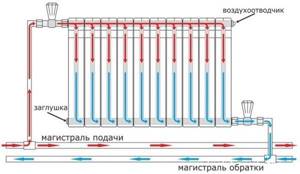
One-way side connection is especially often used in apartment buildings. In this connection option, the supply pipe is located at the top of the radiator, and the outlet pipe is at the bottom. The main difference from a diagonal connection is that both pipes are placed on the same side of the device.
It should be noted that in this case, the heat transfer of the radiator, compared to a diagonal type connection, is reduced by 2%, and if the pipes are located in the reverse order, approximately another 9-10% of the power of the heating device is lost.
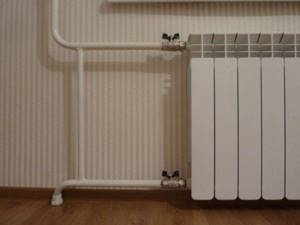
Connecting heating radiators from below is rarely practiced. Most often it is used for main connections, when the supply and return pipes of the coolant cannot be hidden in grooves or behind a false wall.
Connecting a heating radiator intended for the bottom type of installation refers, by and large, to a one-way scheme, since the wiring of both pipes - supply and return - is made inside the device.

When piping a heating radiator with a bottom connection, it is very important not to confuse or swap the supply and return pipes - you should remember that the return supply is always located first from the nearest corner.
How to choose the right thermostatic mechanism for a radiator
When choosing a thermal head, it is necessary to take into account all the features of the installed heating system. Taking into account these features, as well as the installation conditions of radiators, a wide selection of combinations of heads and valves opens up.
For example, if your heating system is identified as a one-pipe system, valves with maximum water flow capacity are best, as are two-pipe systems where water moves naturally without the intervention of any mechanisms.
But if you use a two-pipe radiator , in which the water supply is due to a circulation pump, then it is best to select a valve that regulates this very supply.
Once the correct decision on valve selection has been made, you can proceed to the thermal head itself.
There are five most common and affordable Kermi thermal head options that you can buy, namely:
- invoice with internal thermoelement;
- electronic with programming capabilities;
- with external temperature sensor;
- anti-vandal;
- thermal heads with external regulator.
Classic thermal heads, in which the temperature sensor is installed internally, are installed in cases where the axis of the device is in a horizontal position after installation.
Many professionals recommend not installing the thermal head on a heating radiator in a vertical manner. The fact is that the heat that comes from the radiator will greatly affect such an installation, as a result of which the device with almost 100% probability will not function correctly.
If for some reason it is not possible to install the head horizontally, you can use a special remote temperature sensor, which is attached to the capillary tube.
Read also: Features of the structure and properties of thermoplastic polymers
There are other reasons for installing an external temperature sensor, namely:
- If the radiator is located behind the curtains.
- If there is another heat source next to the thermal head.
- If the battery is located under a large window sill.
As for electronic sensors with an external display and programmability, they also come in two types:
- with built-in control unit;
- with a removable (remote) control unit.
Devices with a removable control unit can also continue to operate after it is separated from the structure, which is not the case with the option with a built-in unit. However, naturally, the price of the second option is slightly higher .
These types of thermal heads can significantly reduce the price of electricity, since they allow you to regulate the temperature in different modes and at different times of the day. This way you can reduce the heat level during the day and increase it at night.
Anti-vandal devices will be an excellent solution for homes with small children. As we all know, children always love to touch and play with everything. And this is not always safe both for children and for the mechanisms themselves in the house. Anti-vandal thermostats will protect the mechanism settings from vandalism performed on them. In public buildings, oddly enough, such thermal heads have also become widespread.
Principles for connecting steel batteries
Lateral connection.

The most popular is the classic lateral connection, passing through the following path: the supply pipe is connected to the upper branch pipe, the pipe through which the “return” passes is connected to the lower branch pipe. Both pipes are parallel to each other on one side.
This principle allows you to achieve maximum effect from the operation of the heat supply system. Maximum heat transfer is the main advantage of this method.
Steel radiators with a side connection type have prices slightly lower than models with similar technical characteristics with bottom connections.
